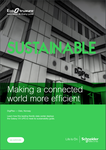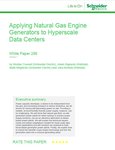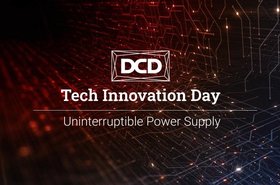Schneider’s new Galaxy V series UPS can address customer needs for sustainability, with better power efficiency and, therefore, a reduced carbon footprint; offers greater redundancy for a higher level of resilience; and all on a more compact footprint.
“The range starts with our Galaxy VS – ‘S’ is for small – available in 10-to-150 kilowatt capacities. It is designed for edge-, small- and medium-sized data centers, and other business-critical applications. Then, moving up in capacity to the Galaxy VM – ‘M’ is for medium – available in 160 and 200kVa. It is designed for major data centers, and industrial and facility applications.
“And the new Galaxy VL – ‘L’ for large – is available in 200 to 500 kilowatt capacities and is designed for medium-sized and large data centers, for colocation providers, and for mission-critical applications,” said Jacob Friborg, Schneider Electric’s three-phase UPS category manager, based in Denmark, speaking at DCD’s recent Tech Innovation Day, The Future of Data Center UPS.
“Finally, we have our flagship the Galaxy VX – ‘X’ for extra large – available in 500-to-1500kVa. This is designed for large data centres, colocation providers, cloud and service providers,” added Friborg.
However, in the presentation, Friborg focused in-depth on the Galaxy VL.
“The Galaxy VL is available in one frame size rated for 500 kilowatts. The Galaxy VL can be configured starting at 200 kilowatts, and then scaled up in capacity to 500 kilowatts... At the upper part of the unit, we have the input-output cable connection where all the cables have been connected behind the metal cover. We also have located in the opposite section of the UPS a network management card, so the unit is ready to be connected. We also have space for an optional backfeed protection kit,” said Friborg.
He added that the Galaxy VL also offers double conversion mode. “In double conversion mode, AC power is connected to the input PFC of the UPS. The input rectifier then converts the AC into DC and the DC is used to charge the batteries. The DC then goes to the output inverter, the output inverter converts the DC back to AC to supply the load connected to the UPS,” explained Friborg.
“Galaxy VL also has what we call multi-mode operation, which means it offers an ultra-high efficiency mode… where the efficiency of the UPS is boosted from 97 percent, meaning that energy is saved and true emissions reduced.
“So, how does it work? In e-conversion mode, the input PFC rectifier is turned off. This is to save energy and to improve the overall efficiency of the UPS. What really differentiates the Galaxy VL’s e-conversion mode from high-efficiency modes from other UPS manufacturers is this clever feature [whereby] the output inverter of the UPS is not turned off, but kept on, but running in idle mode. So, the output inverter is not really doing anything and is therefore not wasting any unnecessary energy. Since the output inverter is kept on, the inverter is always ready to take over the load in case of an external power fault,” says Friborg.
Moreover, claimed Friborg, the financial savings that can be made by making use of features such as the e-conversion mode are not just significant, but could pay for the device within just two-and-a-half years – not to mention the contributions to corporate sustainability targets that it could make.
Missed DCD’s recent Tech Innovation Day, The Future of Data Center UPS? Stream it on-demand now.
More...
-

DigiPlex, a leading Nordic data center, partners with Schneider Electric to meet sustainability goals
Learn how this leading Nordic data center deploys the Galaxy VX UPS to meet its sustainability goals.
-

Mission Critical Power Trends Report
Download this free report from Schneider.
-

Applying Natural Gas Engine Generators to Hyperscale Data Centers
Download this free whitepaper from Schneider Electric.


